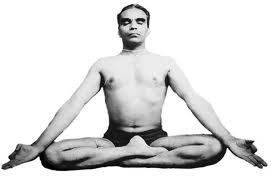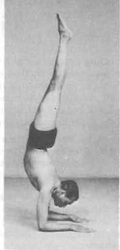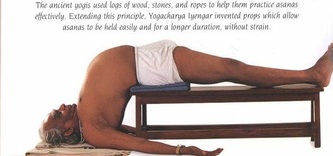Yoga is...
|
...an ancient art, science, and philosophy that emphasizes performing one’s daily responsibilities with awareness, integrity, and compassion. From Sanskrit, the word “yoga” translates as union of the mind, body, and spirit. For many, that includes an ongoing practice of yoga postures. Working through the instrument of the body, yoga teaches one to observe and integrate body, breath and mind, to penetrate beyond the outer, physical layers and reach the inner sheaths of one’s being.
Philosophy of YogaPatanjali, a scholar who lived approximately 2500 years ago, is credited with having written the Yoga Sutras, 196 terse aphorisms that teach about Ashtanga (eight limbed) Yoga. The “eightfold path,” includes yama, niyama, asana, pranayama, pratyahara, dharana, dhyana, and samadhi, and is non-linear. In fact, all the limbs may be practiced and integrated into asana, the third limb of Asthanga Yoga—this is one of the most innovative and distinguishing aspects of BKS Iyengar’s methodology. For example, the complete attention and presence required of dharana (concentration) can be achieved through the self-awareness brought by focusing on the alignment, actions, and techniques of any given posture. Yama, universal moral values, are also to be observed within the practice of asana. By recognizing limits within asana practices, to avoid injury and self-harm, one adheres to Ahimsa (nonviolence) ,one of the yamas. These principles should be transferred to your daily life, words, thoughts, and deeds.
|
Ashtanga Yoga: the Eight Limbs of Yoga
|
Yama: Universal moral values: nonviolence, truth, non-stealing, continence, non-coveting
Niyama: Self-purification by discipline: cleanliness, contentment, burning desire, self-study, dedication of one’s actions to the Divine Asana: Postures, sequenced together to achieve a state of integrated well-being Pranayama: Regulation of the life force through channeling the breath Pratayahara: Withdrawal of the mind from the domination of the senses Dharana: Concentration, single-pointed attention Dhyana: Meditation, attention focused internally and externally at the same time Samadhi: State of absorption in which the aspirant is one with the object of meditation |
B.K.S. Iyengar
|
B.K.S. Iyengar is the most prominent figure in the world of yoga, for the level of his practice and his teaching.
The teacher (1918-2014) called Guruji by his students, lived and taught in Pune (India) in the Institute dedicated to the memory of his wife, Ramamani Iyengar Memorial Yoga Insitute, where today his sons Geeta and Prashant Iyengar continue with passion his work of study and deepening of Yoga. The institute, famous center of international study, is dedicated to the practice and training of students and teachers from all over the world, and has also a section devoted to the study of the therapeutic effects of Yoga. His life B.K.S. Iyengar was introduced in the West in the sixties by the famous violinist Yehudi Menuhin, who met the Maestro during a tour and was fascinated by the strength of his teaching and his charismatic personality. Later Menuhin wrote the preface of the Master's most famous works:
His teaching More than any other teacher, he has stimulated interest in the practice and spread of Yoga internationally, teaching and giving demonstrations all over the world for over seventy years. Thanks to his work and his teachings IYENGAR Yoga Centers were born all over the world (Europe, United States and Canada, Australia, Central and South America, Russia, China and many others). B.K.S. Iyengar is a great innovator in the history of Yoga, unique in its kind, having devoted a great deal of energy to the development of a teaching of Yoga that makes it accessible to all students of all ages, constitution, and physical ability. For this purpose, Iyengar is famous for having introduced the use of tools(props) in the practice of Yoga. B.K.S. Iyengar considered his body as a laboratory, investigated it thoroughly and developed a very accurate teaching and practice method, so that his teachers can guide all the students in the best possible way. The peculiar genius of B.K.S. Iyengar resides in his ability to articulate, in very precise details, the exact alignment required to correctly perform an Asana, so that a constant practice and the consequent process of refinement - enhancing body, mind and spirit - awaken the intelligence of each single cell. The body thus becomes a true instrument and object of meditation, predisposing the practitioners to control the senses, developing a concentrated and meditative mind. On August 20, 2014 he left the body. |
|
Iyengar Yoga…
…is the world’s most widely practiced method of yoga, taught in the tradition of Yogacharya B.K.S. Iyengar. He has made yoga relevant to modern life and accessible to a broad base of individuals, no matter their physical and/or mental abilities. The system of teaching is methodical and progressive, emphasizing safety, alignment, and the development of exquisite self-awareness. He is the author of the classic Light on Yoga, called the “bible of yoga,” which has been the source book for generations of yoga enthusiasts. Iyengar’s teachings have systematically evolved precise posture (asana) and breathing (pranayama) techniques with a firm philosophical base; according to this unique perspective, the asanas and pranayamas are the means and the medium to explore the more internalized limbs of yoga, including meditation (dhyana) and kaivalya (absolute freedom). BKS Iyengar revolutionized the art of yoga by introducing and incorporating the use of supports called “props” to facilitate learning and accommodate safe appropriate progress. Based in Pune, India, his daughter, Geeta, and son, Prashant, are also accomplished teachers of yoga.
Iyengar aphorism
“The beauty of a lake reflects the beauty around it. When the mind is still, the beauty of the Self is seen reflected in it.”
♥♥♥♥♥♥
“Intellectuals tend to be arrogant. Intelligence, like money, is a good servant but a bad master. When practicing pranayama, the yogi [makes] himself humble and without pride in his intellectual attainments.”
♥♥♥♥♥♥
“The body is your temple. Keep it pure and clean for the soul to reside in.”
♥♥♥♥♥♥
“When you inhale, you are taking the strength from God. When you exhale, it represents the service you are giving to the world.”
♥♥♥♥♥♥
“The rhythm of the body, the melody of the mind & the harmony of the soul create the symphony of life.”
♥♥♥♥♥♥
“Illuminated emancipation, freedom, unalloyed and untainted bliss await you, but you have to choose to embark on the Inward Journey to discover it.”
♥♥♥♥♥♥
“Change leads to disappointment if it is not sustained. Transformation is sustained change, and it is achieved through practice.”
♥♥♥♥♥♥
“It is through your body that you realize you are a spark of divinity.”
♥♥♥♥♥♥
“Yoga teaches us to cure what need not be endured and endure what cannot be cured.”
♥♥♥♥♥♥
“Yoga, an ancient but perfect science, deals with the evolution of humanity. This evolution includes all aspects of one’s being, from bodily health to self-realization. Yoga means union – the union of body with consciousness and consciousness with the soul. Yoga cultivates the ways of maintaining a balanced attitude in day-to-day life and endows skill in the performance of one’s actions.”
♥♥♥♥♥♥
“The practice of yogasana for the sake of health, to keep fit, or to maintain flexibility is the external practice of yoga. While this is a legitimate place to begin, it is not the end… Even in simple asanas, one is experiencing the three levels of quest: the external quest, which brings firmness of the body; the internal quest, which brings steadiness of intelligence; and the innermost quest, which brings benevolence of spirit.”
♥♥♥♥♥♥
“Often, we hear people saying they remain active and light when they do just a little bit of asana practice. When a raw beginner experiences this state of well-being, it is not merely the external or anatomical effects of yoga. It is also about the internal physiological and psychological effects of the practice.
♥♥♥♥♥♥
“Intellectuals tend to be arrogant. Intelligence, like money, is a good servant but a bad master. When practicing pranayama, the yogi [makes] himself humble and without pride in his intellectual attainments.”
♥♥♥♥♥♥
“The body is your temple. Keep it pure and clean for the soul to reside in.”
♥♥♥♥♥♥
“When you inhale, you are taking the strength from God. When you exhale, it represents the service you are giving to the world.”
♥♥♥♥♥♥
“The rhythm of the body, the melody of the mind & the harmony of the soul create the symphony of life.”
♥♥♥♥♥♥
“Illuminated emancipation, freedom, unalloyed and untainted bliss await you, but you have to choose to embark on the Inward Journey to discover it.”
♥♥♥♥♥♥
“Change leads to disappointment if it is not sustained. Transformation is sustained change, and it is achieved through practice.”
♥♥♥♥♥♥
“It is through your body that you realize you are a spark of divinity.”
♥♥♥♥♥♥
“Yoga teaches us to cure what need not be endured and endure what cannot be cured.”
♥♥♥♥♥♥
“Yoga, an ancient but perfect science, deals with the evolution of humanity. This evolution includes all aspects of one’s being, from bodily health to self-realization. Yoga means union – the union of body with consciousness and consciousness with the soul. Yoga cultivates the ways of maintaining a balanced attitude in day-to-day life and endows skill in the performance of one’s actions.”
♥♥♥♥♥♥
“The practice of yogasana for the sake of health, to keep fit, or to maintain flexibility is the external practice of yoga. While this is a legitimate place to begin, it is not the end… Even in simple asanas, one is experiencing the three levels of quest: the external quest, which brings firmness of the body; the internal quest, which brings steadiness of intelligence; and the innermost quest, which brings benevolence of spirit.”
♥♥♥♥♥♥
“Often, we hear people saying they remain active and light when they do just a little bit of asana practice. When a raw beginner experiences this state of well-being, it is not merely the external or anatomical effects of yoga. It is also about the internal physiological and psychological effects of the practice.
Gokarna Yoga School, Kudle beach/Hill Top, Gokarna, Karnataka, India





















